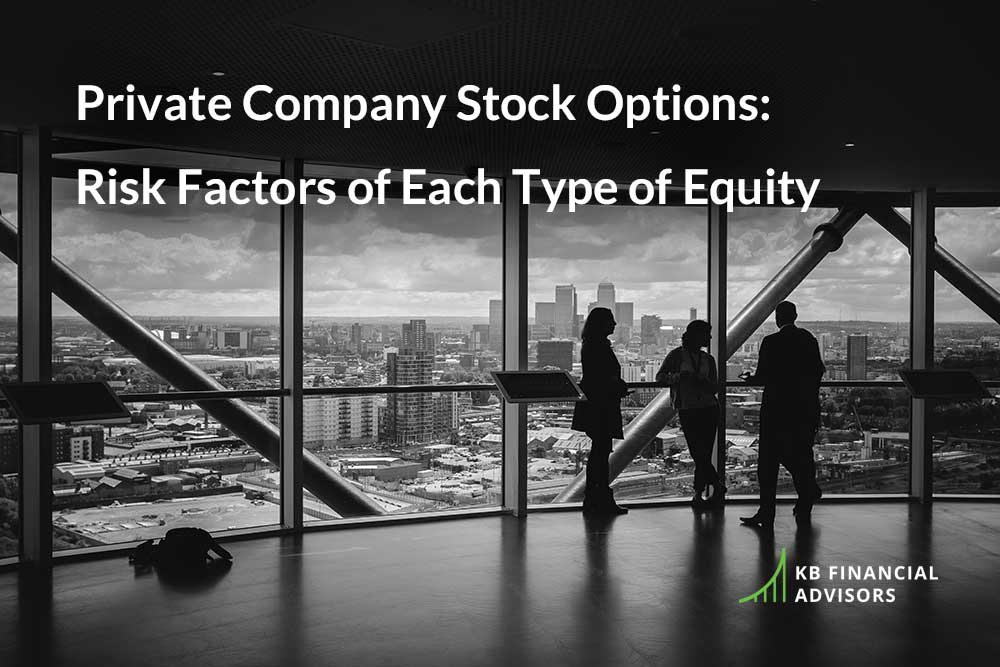In any private tech company, there are typically five types of stock options available:
- QSBS (qualified small business stock)
- LTCG (long-term capital gains) Shares
- Unexercised ISO (incentive stock options)
- Unexercised NQSO (non-qualified stock options)
- RSU (restricted stock units)
???? And if your eyes glazed over looking at that list, I don’t blame you. ????
Only nerdy tax accountants & financial planners like me get excited when we see lists like this. ????????♂️ (And even then, I sometimes rub my forehead because I know I’m in for some serious paperwork.)
The thing is, when you’re going to invest in your private company stock options as an employee, it’s really important to know the differences between these five types of equity. (And beyond knowing the difference in definitions, to know the risks involved in each one, so you know how to get the most out of each one.)
Each one carries three types of risk:
1. Cost Risk: The cash and tax money you have to part with to exercise.
2. Investment Risk: How this particular investment opportunity would perform for you compared to other investment opportunities. (Like in the stock market or other companies.)
3. Career Risk: The “golden handcuffs” when you have options that you can’t afford to exercise yet, so you have to stay at the company for the time-being and limit your career opportunities.
Some types of private company stock options ARE better than others, and not all of them are created equal. And that’s what I’m going to walk you through in this post: the differences in these types of equity & the risks involved so you can make the best decision for your situation.
1. QSBS – Qualified Small Business Stock
Qualified Small Business Stock is obtained when you’re an employee of an early-stage startup. It doesn’t require exercise, either: you either have it from a past exercise of stock options, or they’re founders shares.
These are one of the least-risky equity types, because they don’t come with a capital gains tax that you have to pay when you sell.
Cost Risk
QSBS carries little to no cost risk. If the company has made it for five years and you’ve held onto your shares all that time, you’re likely to have massive gains.
Plus, they’re shares that you already own, so there’s no cost to exercise. There’s also no direct tax cost. According to Section 1202 of the Internal Revenue Code, it’s possible for 100% of your capital gains to be excluded from taxation when you sell these shares.
The only cost risk is if something seriously awful happens to the company that would result in a realized capital loss when you sell. But since this isn’t likely, you probably won’t have to worry about reporting losses on your taxes for years and years, like could happen with long-term capital gain shares or RSU released at IPO.
Investment Risk
Since QSBS doesn’t require exercise, the investment risk is also pretty minimal. However, if you haven’t hit the five-year mark yet, it may be worth considering if you could cash out and get a better return on that money elsewhere.
If you do decide to sell to mitigate your investment risk, a Section 1045 rollover is a way you can avoid the tax cost of selling. This rollover lets you take Qualified Small Business Shares from one company, sell them, and re-invest them in another company that meets the QSBS standards within 60 days. If you do this, that invested money can continue to grow until the five-year mark hits, and those gains will still be exempt from long-term capital gains tax.
For example, if your shares aren’t five years old yet and you feel like the current company you’re invested in is going to tank, you can sell those shares, and re-invest that money in another new business you think has a brighter, more profitable future. As long as this re-investment is done within 60 days, and the new business fits QSBS guidelines, you can continue to avoid the capital gains tax.
Career Risk
Both QSBS and shares for long-term capital gain carry no career risk. The shares are yours, and your employment status at the company they’re from doesn’t change that. There’s no reason to stay an employee at the company they’re from in order to maintain those shares. (Unless, of course, you want to keep working there, then that’s fine. But these shares do not hold back your career in any way.)
2. Long-Term Capital Gain Shares
Shares for long-term capital gains are usually from the exercise and hold of stock options..
These shares must be held for at least one year, and tax on them is less than ordinary income tax.
Cost Risk
There are two types of cost risk for long-term capital gains shares, and they both have to do with taxes. One is the cost of taxes you have to pay when you sell, and the second is the way capital losses are treated by tax law if the shares don’t do well.
All the cost risk of long-term capital gain shares is related to taxes. There is the direct cost of the taxes you owe when you sell.
Unrealized capital losses can also create an indirect cost. Indirect in terms of the money you lost and the disadvantaged way that realized capital losses are treated.
First, let’s talk about the tax bill from selling:
Long-term capital gain shares create an unrealized, future tax bill. These taxes range anywhere from 15% to 23.8%, which is an 8.8% difference.
The thing is, with salary, bonuses, and the “income” of vested shares, it’s really easy to tip yourself over into owing 8.8% more without realizing it. If you don’t plan carefully, you could get an ugly tax bill. The good thing is, though, you can plan carefully and do some tax-rate arbitrage. (Which I know sounds fancy and like it’s part of the Ocean’s Eleven plot, but really just means making sure that when you sell these shares, you do so at a lower tax rate.)
Now let’s talk about the tax cost risk of capital losses.
Really, the tax law sucks here. Let’s say you invest in some company stock options, hold for a year, and sell at a significant loss. It’s not the ideal situation, but it does happen sometimes.
Most tech employees aren’t old enough to have a lifetime’s worth of capital gains to offset a massive loss here, so they’ll be stuck reporting measly $3,000 losses every year (what’s allowed by the IRS) for years on end before they’re able to break even tax-wise. Not to mention dealing with the massive money loss from an investment gone bad.
Investment Risk
Investment risk is the most significant risk for long-term capital gain shares.
The thing is, your money is your money. If you choose to invest a sum of it in your private company stock options, that’s a sum of money you can’t invest elsewhere. You need to make sure you’re confident that these shares will out-perform other investment options you have available… even a Vanguard Total Stock Market fund.
Or making an investment in another startup.
Yes, really.
This is your financial well-being we’re talking about here, so this is something to take into heavy consideration. Just because you have stock options available doesn’t mean you’re obligated to exercise them. Look out for yourself and make sure you’re making a sound financial decision by exercising your company stock options.
Hot tip: A great way to avoid risk with long-term capital gains shares is knowing WHEN to sell. It’s a good idea to decide beforehand a sell price you’re happy with, and to sell when the stock reaches that price.
3. Unexercised ISO & NQSO
Stock options, are typically a part of your employee compensation package. Here, your company gives you the option to buy stock in the company at a fixed price that doesn’t change no matter what happens to the price of the stock in the market. (So this can mean gaining the opportunity to buy in at a price lower than market value.)
With these types of options, there are two types: ISO (incentive stock options), and NQSO (non-qualified stock options).
ISO allow you to exercise and pay no regular income tax at the time of exercise. But you may trigger the alternative minimum tax (AMT) when you exercise.
NQSO (non-qualified stock options), on the other hand, are basically the same, except you have to pay ordinary income tax on the “profit” you receive when you buy. (For example, if you buy a share for $7, and the market rate is $10, you have to pay tax on that $3 difference.)
Cost Risk
There are two types of cost risk for unexercised stock options: one is the cash you have to pay to exercise, and the second is the tax cost.
For both ISO and NQSO, the cash cost risk is easy to calculate: Multiply the number of shares you want to buy by the exercise price.
For example: 1,000 shares x $15 per share = $15,000 cash cost.
The tax cost risk is a little different, though.
Tax Cost Risk of NQSO
As soon as you exercise, NQSO are taxed as ordinary income.
My recommended way of mitigating this risk is to decide on a price you’d like to sell at, and then exercise and same-day sale your shares when the market value hits that price. This way, you’re not out any cash to exercise, and you have cash from the sale to pay the taxes.
Tax Cost Risk of ISO
While the cash cost to exercise ISO is the same as NQSO, the tax cost may actually be less.
Unlike NQSO, ISO are not taxed at the same rate as regular income, but they do carry the possibility for triggering the AMT (alternative minimum tax).
Most of the clients I work with have a $30,000 to $70,000 window to play with when exercising ISO before they have to pay the AMT, so calculating what that window amount is for you is a great way to minimize the tax cost risk when using ISO to invest. (There are also some ways to lower the tax cost at the time of exercise, so this is something I encourage you to work on with a financial planner.)
Career Risk
The golden handcuffs… Career risk is having to stay in a job because you cannot afford the cost risk of exercising your stock options. Most stock option grant agreements require continued employment. The stock options expire often within 90 days of employment ending.
For example, I have one client who earns about $100,000 less in her role at her current company than she would earn elsewhere. This company is private, but they gave her an amazing stock options package. But if she leaves the company, she only has 90 days to exercise her shares, and the total cost of the exercise, tax, and AMT would be around $400,000. Like a lot of tech employees, most of her net worth comes from her stock options, so she needs them… but she can’t afford to actually exercise them if she wants to change jobs.
Some companies will allow you to convert your ISO to NQSO for an extended exercise window that could help mitigate this career risk. Once you convert to NQSO, you don’t have to exercise anymore, and can leave the company whenever you want.
But before you do this, pay attention to the details. Different companies have different policies here, and you don’t want to tie your hands and put yourself in a worse situation than you were before.
5. RSU – Restricted Stock Units
RSU is a form of payment from a company to an employee. Basically, in addition to your salary, you get stock granted to you that you don’t have to buy. RSU are typically granted according to a vesting schedule, and a lot of the time, the first time a person’s RSU will “vest” is during an IPO.
Cost Risk
Most of the time, when a company is about to hit IPO, they have meetings with their employees to tell them that in order to pay for the taxes of their RSU vesting, they’ll be selling 40% of their shares.
This makes employees mad, but it’s the reality of RSU and taxes: they’re the playground bully of private company stock options, and they will ALWAYS steal your lunch money. ????
The thing is, when your RSUs vest, you tax bill on them WILL come due… whether you have the money to pay for it or not. Most companies withhold 22%, but with taxes up to 37%, you could have a 15% gap in what’s been paid and what you owe. If you don’t sell your vested shares, you have to come up with that money from your regular paycheck.
Career Risk
If your RSUs vest, you can usually take them with you if you decide to switch jobs and leave the company. However, it’s important to balance the value of your RSU with your salary offer, plus the value of additional equity you’d be offered by another company. It’s not always an easy calculation to make. The thing you want to make sure of, though, is that you’re not getting the financial “short end of the stick” if you decide to stay or transfer elsewhere.
And while this career risk does boil down to money, it’s important to not just think about money when you’re weighing the career risk here. Think broader than money. For example, having an IPO from a well-known company on your resume may be even more valuable than having an Ivy League degree. So if you expect the company to have a big IPO, even if the money isn’t as good, it could be worth the risk in the long-term.
Weighing the Risks of Your Private Company Stock Options & Deciding What to Do
Deciding what to do with your investment options involves a lot of math.
- How much can you afford to invest in your ISO before your trigger the AMT?
- Do you have enough money to exercise your ISO so you can switch jobs and advance your career?
- How much tax money should you set aside when you sell your LTCG shares?
But these decisions also involve a lot of non-math factors, too.
- Would it be worth it to you to sacrifice $50,000 additional salary per year in a new job for three years while you wait for a massive IPO?
- Do you think your company will be the next “big thing” and therefore worth sticking around waiting on RSU to vest?
Figuring out the answers to these questions isn’t easy, but it helps to have someone experienced with employee finances in the startup world to guide you.
Booking a call with me or one of our other team members can get you on the right track to making the most out of your company stock options and your career advancement.






